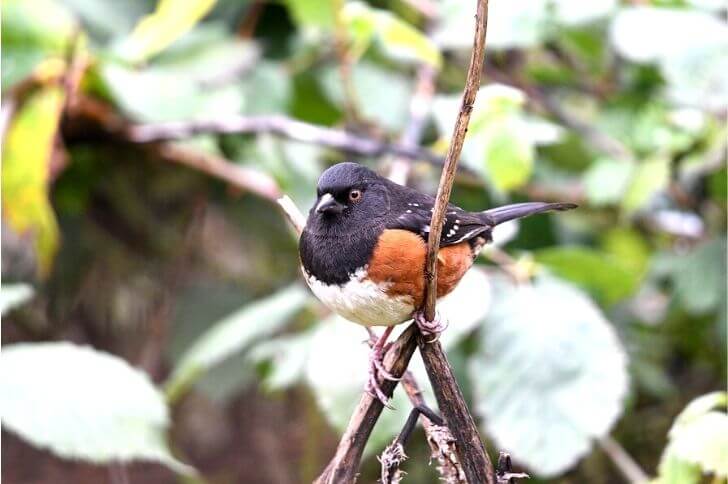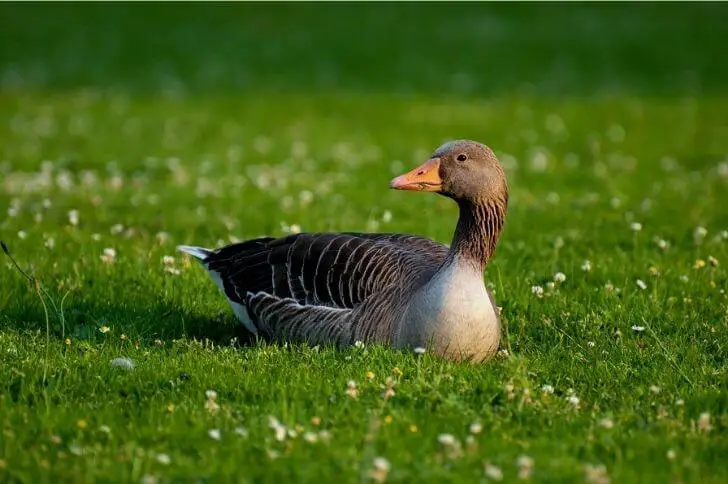How many black, orange and white birds can you name? I found myself scratching my head when my fifth grade daughter asked me this question. Like most people, I could only think of two birds; the Eastern towhee and the streaked-backed oriole.
Feeling challenged, I went down a rabbit hole and came up with this comprehensive list of orange and black birds that have some white plumage on their feathers. These bird species are not only unique but also interesting to watch.
List of black orange and white birds
1. Black-headed Grosbeak

Known for its sweet, whistled songs, the black-headed grosbeak is a medium-sized seed-eating bird that is found in woods and brushy areas across North America.
Identification:
The adult male has a black head, wings, and tail with white wing bars. Underneath the male is a dark orange in color. Female black-headed grosbeak is a duller brownish color with white eyebrows and wingbars.
Both sexes have slightly forked tails and hefty canonical bills that come in handy during meal time. On average, the adult is 7.1-7.5 inches, slightly smaller than a blue jay. They span 12.6 inches.
Other facts:
These birds are often seen feeding on sunflower seeds, fruits, and insects. During the breeding season, the male black-headed grosbeak will sing a loud song from a high perch in order to attract mates.
The female will build a cup-shaped nest out of twigs and leaves, which is usually located in trees or shrubs. Both parents help to raise the young birds, which fledge (leave the nest) after about two weeks. How long can these orange birds live? Grosbeak’s lifespan is about 11 years.
2. Eastern Towhee

Remember the black orange and white bird I mentioned earlier? Yup, it’s this beautiful bird. The eastern towhee is a songbird of the New World sparrow family. It is the largest and darkest member of the genus Pipilo.
Identification:
The eastern towhee occurs from southeastern Canada to northern Florida and Louisiana. Male has a black head, darker than most birds on this list. The back, wings, tail and throat are also black. Underparts are orange and white. In contrast, the female eastern towhee is mostly brown with bright orange plumage on their sides.
Both sexes spot gorgeous red eyes and thick bills. An adult size varies from 6.8-8.2 inches with a body mass of 1.1-1.8 oz.
Other facts:
It is a non-migratory bird that ranges in habitat from woodlands to gardens. The eastern towhee feeds on insects, spiders, and snails.
During the breeding season, which starts in early spring, these orange and black birds nest on the ground. A pair looks for the material but the female bird does all the construction. Breeding eastern towhees raise up to three broods during the nesting season.
3. White-throated Rock Thrush

Found in most parts of Asia, the white-throated rock thrush is a species of bird in the family Muscicapidae.
Identification:
The white-throated rock thrush has a rich orange underparts, blue crown and shoulders, black back and wings with a white patch. Females are mostly brown with distinctive scaly markings. It is about 6.3-7.5 inches long, the same size as an American robin.
Other facts:
The diet of the white-throated rock thrush consists of insects, spiders, and small lizards. Nesting season starts from May through September. They raise two broods. They are a migratory bird species, moving to warmer regions during cold months.
4. Flame-colored Tanager

Flame-colored Tanagers are small songbirds with a large range, stretching from Mexico to Ecuador.
Identification:
The male of the species is striking in color. Its underparts are bright orange-red. Upperparts are black with white spots. Note the bright red-orange head. The female is also as brightly colored, with stunning yellow underparts.
Other facts:
The Flame-colored Tanager is found in a variety of habitats, including mountain forests, woodlands, and even gardens. It feeds on arthropods and berries.
This colorful little bird is not currently considered at risk of extinction. When birding, its “per-dick” calls will alert you to its location.
5. Flame Robin
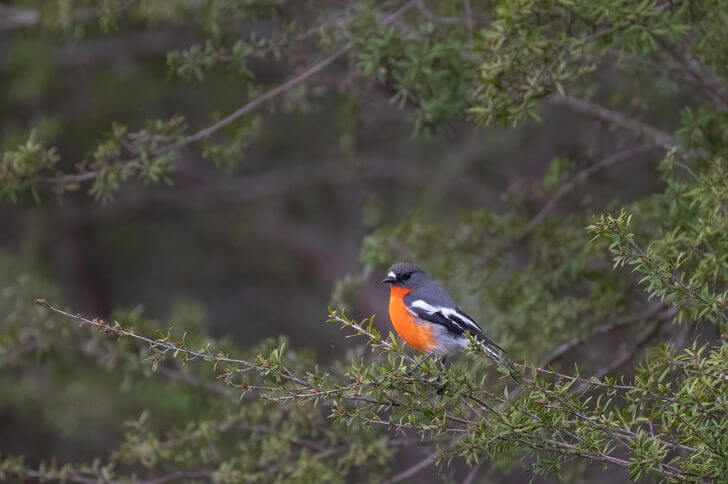
A flame robin is a small, brightly colored bird that is found in Australia and New Zealand. It is the same size as a chickadee but with gorgeous plumage that makes it a worthwhile find.
Identification:
These birds are sexually dimorphic. The male flame robin has a red-orange breast and belly, while the female has a gray breast and belly. Also males have a black back with white on the forehead and wings.
Also note his tail feathers are long with white edges and undertail coverts. The adult is 4.5-5.5 inches in length.
Other facts:
It is a member of the Australasian robin family, which also includes the pink robin, scarlet robin, and North Island Robin.
The Flame Robin is found in woodlands, forests and gardens throughout Australia and New Zealand. They are very common birds, and are often seen perching on tree branches or flying from branch to branch in search of insects.
Flame Robins are insectivorous birds, meaning that they primarily eat insects.
6. Streak-backed Oriole
Central and South America are home to this gorgeous orange black and white bird. The streak-backed oriole is a member of icterus which includes other orioles and toupicals.
Identification:
It has a distinctive streaked back, which is what gives it its name. The rest of the body has bright orange plumage. This bird also spots a black face and long tail feathers. Females and male share plumage but juveniles are duller.
Other facts:
The bird is known for its melodious song, and it is often seen in trees or on power lines. These orange and black birds also prefer shrubland, savanna, and grassland. Though it is mostly found in Central America, it is a common visitor in North America during summer month
7. Spotted Towhee

Closely related to the Eastern towhee above, the spotted towhee is a medium-sized bird in the family passerillidae. Its scientific name is Pipilo maculatus.
Identification:
How to identify the spotted towhee? Be on the look for a bird species with black head and wings, rich orange sides and undertail coverts and a white belly.
Note the white marking on its wings. Females and babies are duller. Also note, like the Eastern towhees, these orange birds also sport a long tail and a body length of 6.7-8.3 inches. The towhee’s bill is triangular and short.
Other facts:
The spotted towhee is a shy bird that spends most of its time on the ground in dense vegetation. The bird feeds on insects, seeds, berries, and other small items. It nests on the ground, trees or shrubs, laying 3-6 eggs at a time. And like the birds above, they can raise up to three broods each season.
Spotted orioles are prevalent on western United States.
8. Baltimore Oriole
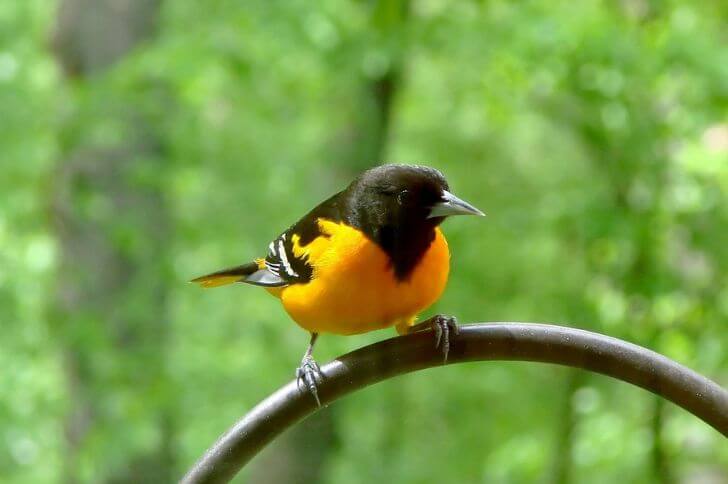
Another group of black orange and white birds are the Baltimore orioles. A migratory species, these unique birds breed in North America and fly south to Central America during winter.
Identification:
The Baltimore oriole is a small songbird with a bright orange breast and black wings. Note its beady eyes and white spots on its wings. Males also have dark gray feet. Female Baltimore orioles are brown above and yellow below. Both sexes spot long, pale and pointed bills.
Also, these orange birds are about the same size as red winged blackbird; 6.7-7.6 inches long and span up to 12 inches.
Other facts:
This Maryland’s state bird prefers wooded areas near streams and forests. When can you see its early life stages? From April to July, these American birds lay eggs and raise their young. And unlike other birds on this list, they’ll only raise one brood per year.
If you want to attract these black, white and orange birds to your bird feeders, we recommend you use sugar water and plant raspberries in your yard.
9. Bullock’s Oriole
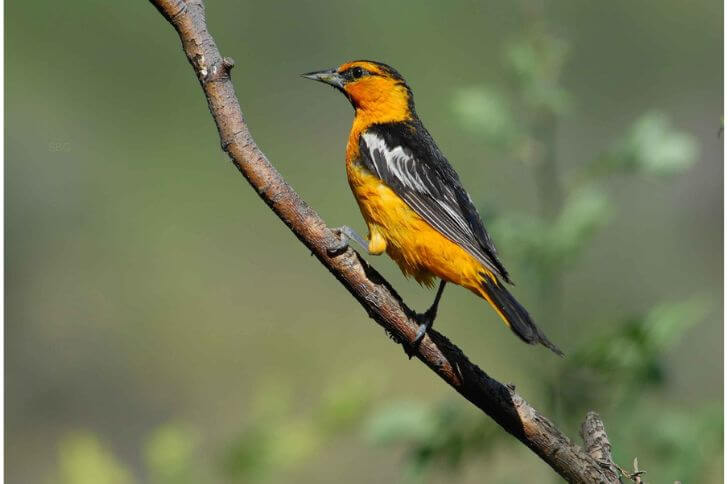
Another beautiful black and white bird with an orange chest that prefers the western United States is the Bullock’s oriole. It is also a member of a large icterus family.
Identification:
The bullock oriole is a medium-size blackbird with bright orange underparts and white wing bars. It measures 6.7-7.5 inches in length and weighs 1-1.5 oz. The males and females are different in plumage. Males have a black head, back, wings, and tail. The underparts are bright orange, and the bill is pale.
The female of this orange breasted bird is grayish above with a yellow-orange head and whitish belly.
Other facts:
This orange black white bird remains agile and active throughout the day. It prefers habitats near streams where it forages for juicy fruits but will also eat caterpillars, ants and leafhoppers. They nest in isolated trees, raising 3-7 oriole babies per season.
10. Royal Tern
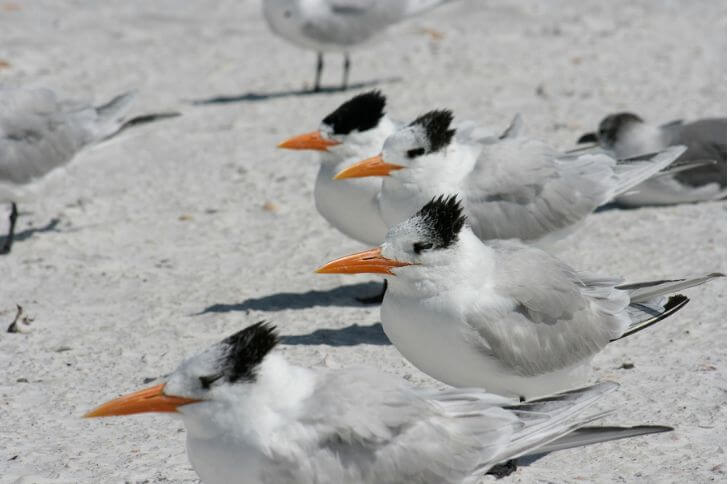
What is a black and white bird with orange beak? Royal terns. A member of the family Laridae, these beautiful shorebirds can be found in Long Island and winter in North Carolina.
Identification:
These birds are easily recognizable by their orange beaks and black-and-white plumage. Royal terns are 17-21 inches in length with a mass that varies from 13.8 to 15.2 oz. Their wings span 39.4-43.3 inches in length, allowing them to fly at speeds of up to 24 miles per hour.
Other facts:
They are skilled hunters, preying on small fish and invertebrates. These birds nest in large colonies, often alongside other seabirds such as gulls and pelicans. The royal tern is a social bird, often seen congregating in large groups on beaches or in estuaries.
Despite being skilled hunters, royal terns are threatened by habitat loss and pollution. These birds rely on healthy coastal ecosystems for their survival, and the decline of these habitats has put the royal tern at risk.
11. American Robin

The American robin is a common sight in North America, and its cheerful song is a sign of spring. But this orange and black bird is more than just a gorgeous face. The American robin is also a skilled hunter and an expert at finding food.
Identification:
This bird gets its name from its reddish-orange breast, which resembles the European robins. It was named by the first settlers. The rest of its body is grayish with a black head. The American robin is also known for its yellow bill and dark gray legs.
Other facts:
The American robin is a member of the thrush family, and it can be found in woods and gardens across the United States. These birds are most active during the day, when they can be seen perching on branches or flying from place to place in search of food.
It mainly consumes fruit and earthworms. However, some birds of this species have been recorded eating snails and snakes.
12. Altamira Oriole

Among the icterus birds, you’ll find this large bird; the Altamira oriole. It is the largest bird in this vibrant family. This oriole is found in the United States and Mexico.
Identification:
The adult has orange underparts, black face and wings. Notice the white wingbars and dark throat. Also on average, the adult is 8.3-9.8 inches in length and a span of 14.2 inches.
Other facts:
Where can you find the Altamira oriole? These birds are found all-year round in Texas. They favor orchards, farms, and riparian lands.
They are insectivores, and their diet consists of beetles, ants, grasshoppers, and caterpillars. This orange bird with black and white wings has “ike” calls. Altamira oriole lays bluish eggs.
13. Blackburnian Warbler
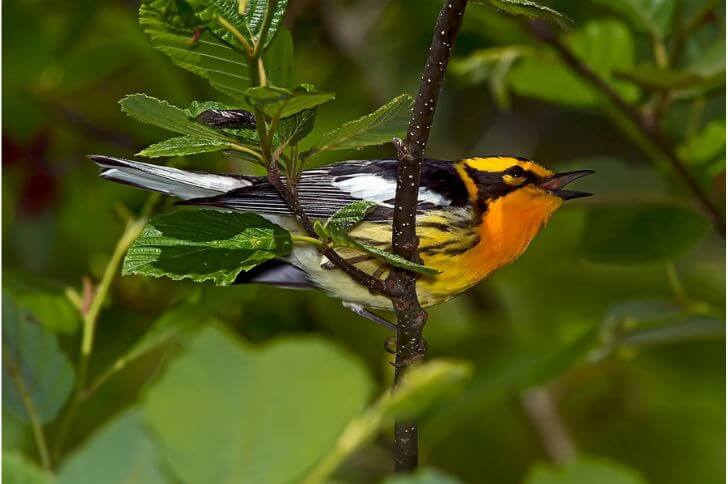
Small and rounded, blackburnian warblers belong to the large warbler family. They get their name from Anna Blackburne; an English naturist from the 1700s.
Identification:
The Blackburnian warbler is black and white with an orange throat. Its underparts are streaked black and white. Females are drabber. It is a small bird, only about 5 inches long. Note its plump body.
Other facts:
The Blackburnian warbler is found in forests where there are lots of trees. It eats insects and sometimes berries. If you’d like to attract them to your yard, we recommend you install bird baths. Each year, these black orange and white birds raise one brood each year.
14. Varied Thrush (Female bird)
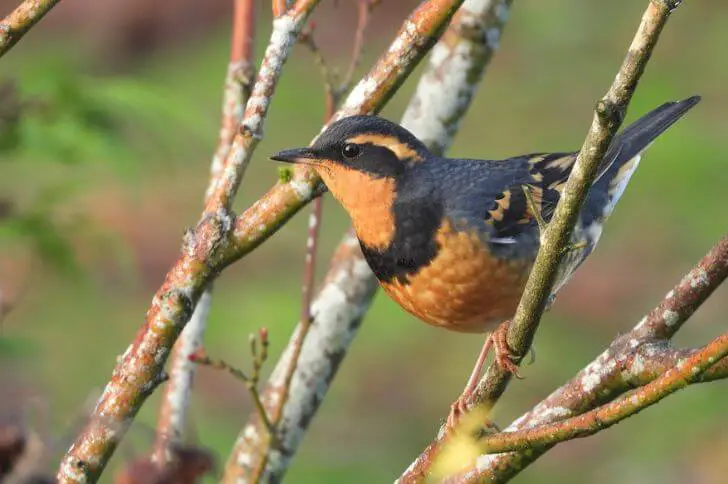
Found during its non-breeding months in Western United States, the varied thrush is a medium-sized songbird with striking plumage.
Identification:
Males are black and orange. Female varied thrushes are mostly brown with an orange breast, throat and eyebrows. Note its black and orange wings and white undertail. They are about the same size as a robin, 7.5 to 10.2 inches in length.
Both sexes have a clear, flute-like song that they often sing from high perches.
Other facts:
Their diet consists mostly of insects and berries. The varied thrush is found in forests across North America, from Alaska to Mexico. They are most common in the western part of their range, but can also be found in the eastern United States and Canada.
They prefer fruits but will consume acorns during winter months. Varied thrushes raise 1-2 broods each season.
15. American Redstart

A common breeder in Eastern United States, the American redstart is a sexually dimorphic bird species that are a must-see for any avid bird watcher.
Identification:
The male American redstart is particularly striking, with vivid black and orange markings on its upperparts. Its belly and undertail are white. The female is more subdued in color, but is still easily recognizable by grayish uppers and whitish below. Note the yellow patches on the sides and fairly long tail.
Other facts:
American redstarts are found throughout the eastern United States and Canada. They are most commonly seen in wooded areas, preferring areas with deciduous trees. These birds are insectivores, and their diet consists mostly of flying insects.
If you want to attract them to your yard, plant some berries. The oldest recorded black, white and orange bird of this species lived for 10 years.
16. Brambling
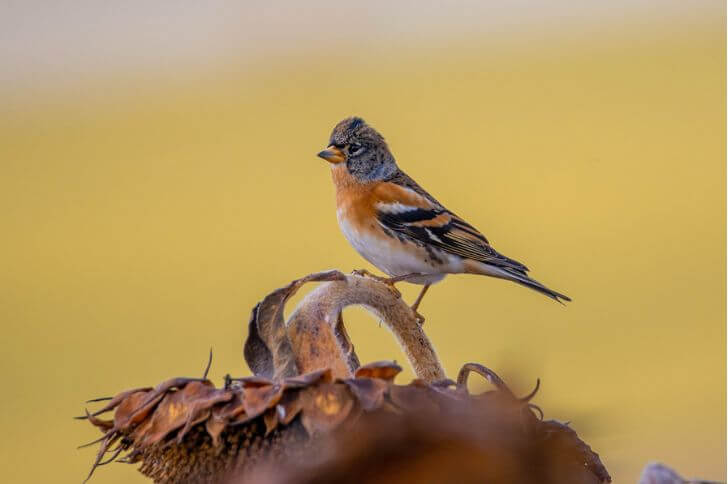
Ever heard of brambling? If you go for a birding tour in Europe or Asia, chances are you’ll come across these brightly colored birds.
Identification:
The Brambling is a 6-8 inches long, delicate bird with a striking black head, orange breast and white belly. It is a member of the finch family, and its scientific name is Fringilla montifringilla. This orange black and white bird has other local names; Mountain finch or cock o’ the north.
Other facts:
The brambling is a winter visitor to the UK, and can often be seen in gardens and parks feeding on berries. It is a very active bird, and is constantly on the move in search of food. It has an impressive flight speed of up to 60 miles per hour!
This orange breasted bird is also known for its beautiful song, which it sings during the breeding season. Bramblings are gregarious birds that mainly consume seeds.
17. White-Browed Robin Chat
Known for its melodious songs and loud “da-da-tee” and “chiiritter-porlii” calls, white-browed robin-chat is a robin-sized bird that ranges from Botswana to the savannas of Kenya.
Identification:
On your safari, you can identify this bird by its orange collar and underparts, dark brown and gray back and a black head. This bird gets its name for the white brows. It is about 7.5-7.9 inches in length with a body mass of 1.8 oz.
Other facts:
They are found in woodlands and gardens in Africa south of the Sahara. The males and females look alike.
These birds nest from July to May, with the clutch consisting of two to three eggs. Their diet is mostly made up of frogs, insects and fruits. The white-browed robin chat is a true delight for any bird lover.
18. King Penguin
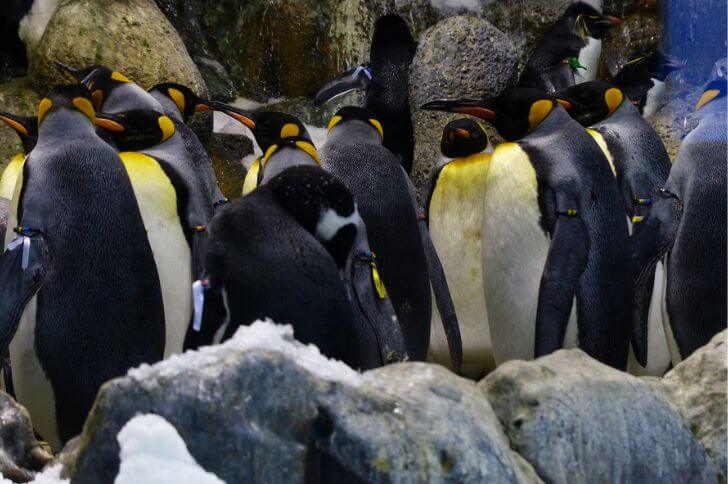
King penguins are native to the cold, remote regions of the southern hemisphere. These regal birds are the second largest species of penguin
Identification:
They are easily recognizable by their orange-yellow and black heads. Sexes are monomorphic, meaning they share similar plumage. The rest of their body is white below and grayish on the back. Note its orange breast.
How can you tell the sexes apart? Male king penguin birds are larger than females.
Other facts:
King penguins are excellent swimmers and can reach speeds of up to 22 mph in the water. But they’re just as comfortable on land, where they use their webbed feet to toboggan across the ice.
Though they breed on Antarctic islands, king penguins will travel hundreds of miles over open ocean to find food for their young. Their diet consists mostly of small fish, squid, and krill.
Final thought on black orange and white birds
From the woods of North America to the savannas of Africa, there are plenty of black orange and white birds to see. In this article we’ve covered some common birds you can see in your backyard as well as some you can plan to see during your next birding tour.
Sources:
https://www.nwf.org/Educational-Resources/Wildlife-Guide/Birds/Eastern-Towhee
https://en.wikipedia.org/wiki/White-browed_robin-chat
Hi fellow bird watcher. Welcome to our small corner of the world. At the spanishbirdguides.com our mission is to share with other bird watchers the things we love about birds, where to go bird watching within the United States, and more. I’d also love to hear from you. Feel free to contact me about your bird watching escapades, share videos, photos and more.
